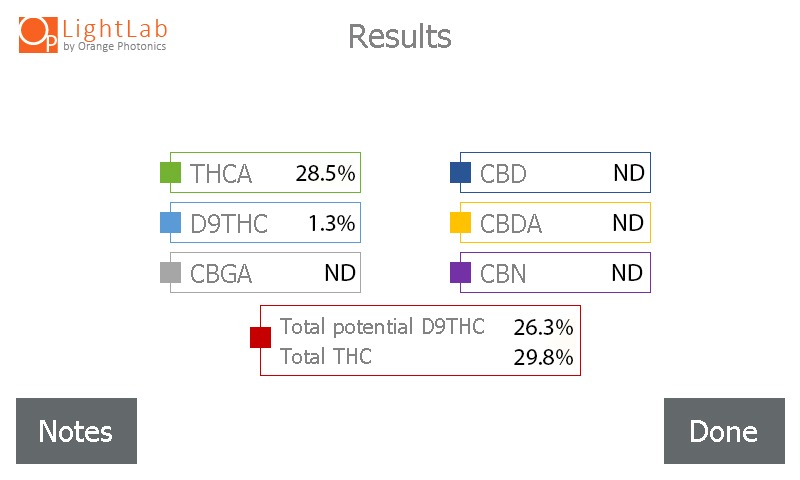Want Good Potency Numbers? Here’s How
The LightLab cannabis analyzer and testing laboratories measure the sample your provide. That said, it isn’t difficult to find someone complaining that their lab gets wildly different results when they send the same sample in twice. There’s a good chance there’s something other than the lab that is causing most of the variation. It seems simple to send two flower samples to a lab (or run them on a LightLab Cannabis Analyzer) and expect the same results, but the samples might not be exactly the same for a variety of reasons. Let’s delve into the most common ones:

- Plant to Plant/Bud to Bud Variation – In a previous post, we showed that there can be significant variation between different buds on the same plant. If you were to analyze two different buds, there’s no guarantee you’ll get the same result even with a perfect lab. Note that even within a single bud there’s variation from the tip to the base.
- Moisture Content – The moisture content of your sample can affect potency results since samples are typically measured by weight percent. Keep in mind a typical cured cannabis sample has 10-15% moisture. If Lab A applies a moisture correction and reports the potency as if the sample has 0% moisture, they will report a potency 10-15% higher than Lab B, who analyzed the sample “as received” which means they make no corrections, and just analyze the sample as it comes in. Tip: LightLab can be set up to run both ways. If the sample was stored in a sealed container and analyzed on a rainy-day vs a hot and dry day, you could get different results.
- Sample Handling – Cannabis in plant form has very sensitive trichomes all over the bud. If you rub your fingers all over one bud and then analyze it, you’ll get much lower results than a bud that hasn’t been touched. If the container the sample is stored in is knocked around, trichomes can easily left behind in the container, resulting in lower potency.
- Trimming Style – It’s no secret that most of the trichomes containing cannabinoids are located on the flowering part of the plant. A really close trim where the buds are handled carefully (see the above point on sample handling) means the sample to be analyzed will contain nearly all densely concentrated trichome material. Conversely a sample that hasn’t been trimmed will contain more leafy material, and therefore less trichomes and a lower potency result.
- Environment – Samples that are exposed to heat or light can degrade and decarboxylate, resulting in higher D9THC levels when compared to THCA, as well as lower potency overall. Samples stored too cold can result in fragile trichomes, so any bouncing around can lead to accelerated trichome loss and lower potency.
With that said, how do you get two flower samples to be as close to the same as possible? Following these steps is a great start:
- Sample Selection – We suggest selecting at least one gram (two is best). If possible, select a top, middle and bottom bud from a plant that is representative of your whole crop, usually near the middle of the grow.
- Sample Preparation – Remove any large stems on the buds and trim the samples as you would typically. Try to handle the sample as little as possible- using gloves will help here. Grind the entire amount of sample using a clean hand herb grinder. Tip: a toothbrush and ethanol work great to clean up your grinder.
- Storage Before Analysis – Once the sample is ground and well homogenized, separate the samples into two small glass or plastic containers that are air-tight and preferably dark or UV blocking. It’s always best to analyze as soon as possible (much easier with a LightLab than a laboratory!), but if you’re shipping the sample take care to pad it so that it’s not shaken around too much, which can cause loss of trichomes. The container shouldn’t have too much air space so the sample isn’t exposed to oxygen or allowed to bounce around inside the container.
- Sample Analysis – If you’re doing the analysis yourself on a LightLab or HPLC, keep in mind the sample preparation will be at least as big of a factor in results variation as the analysis itself. Take care especially during the weighing of the sample, where the most error typically occurs. If a lab grade scale is available, use that. If your sample is a concentrate, heat the sample during extraction and check to make sure it’s fully dissolved in the solvent before analysis.
Since Cannabis is a natural product, no matter what you do there’s going to be some amount of variation. If you follow the steps above, the results you get from a lab or LightLab should be not only more repeatable, but also a better representation of the cannabinoid content your product or crop really contains.
